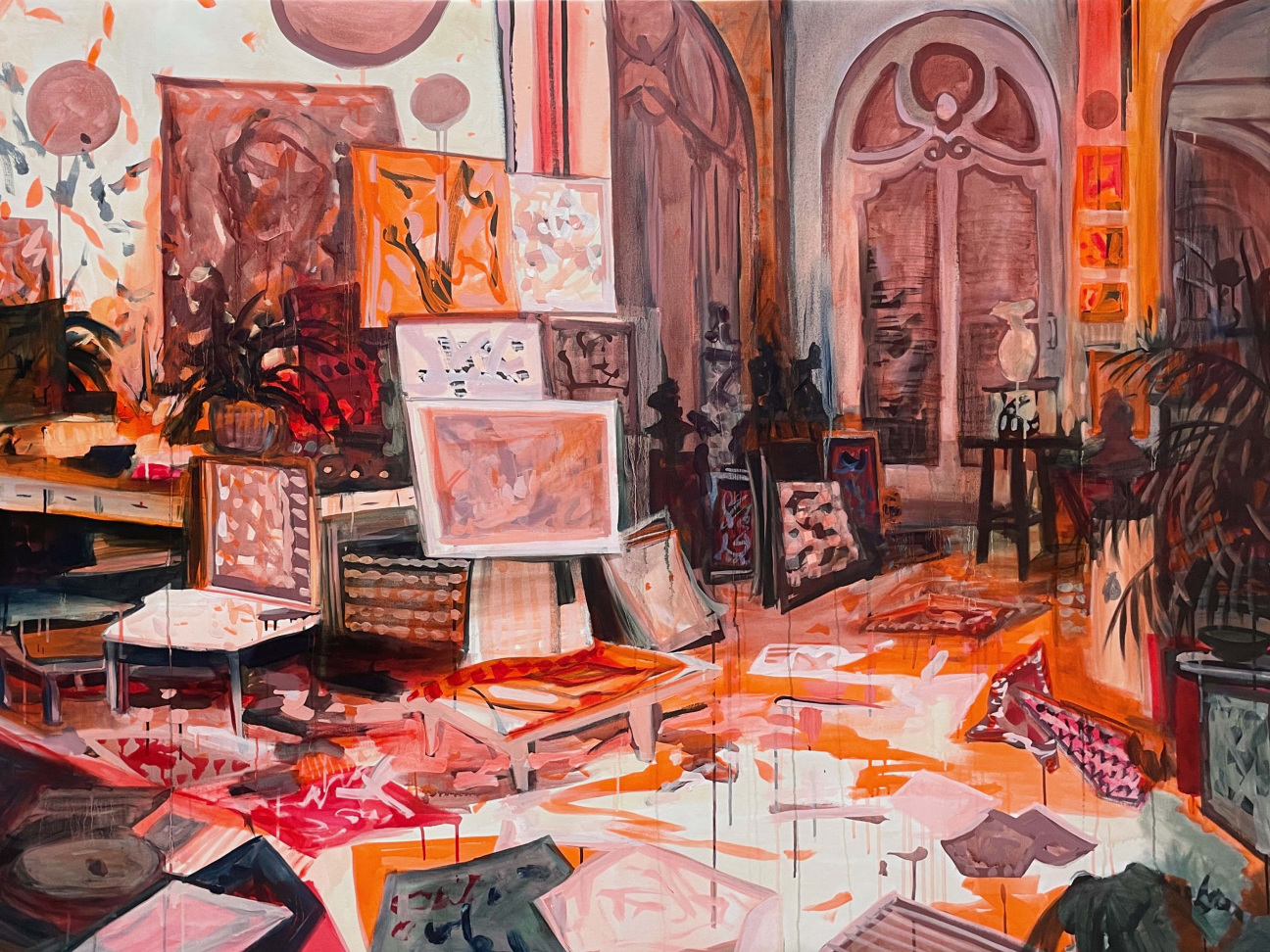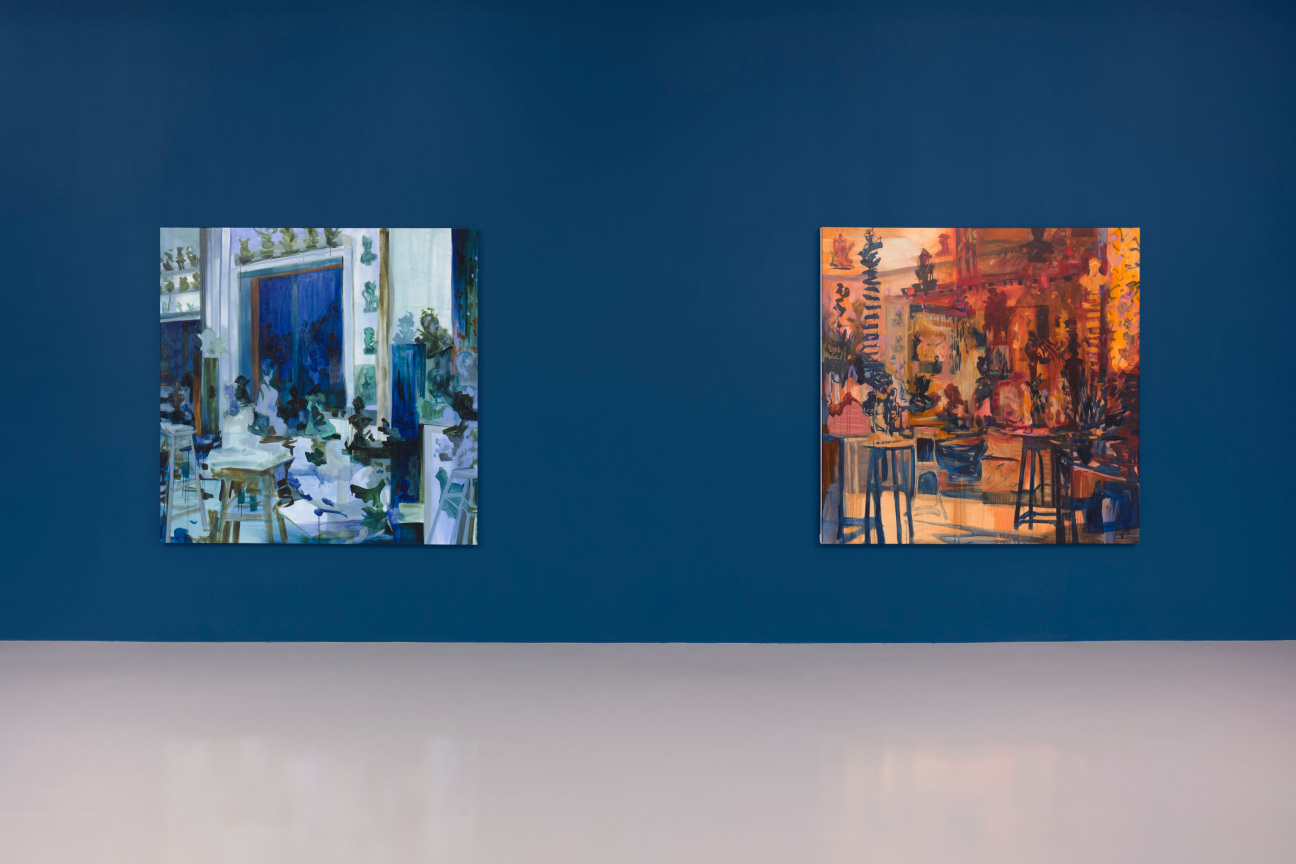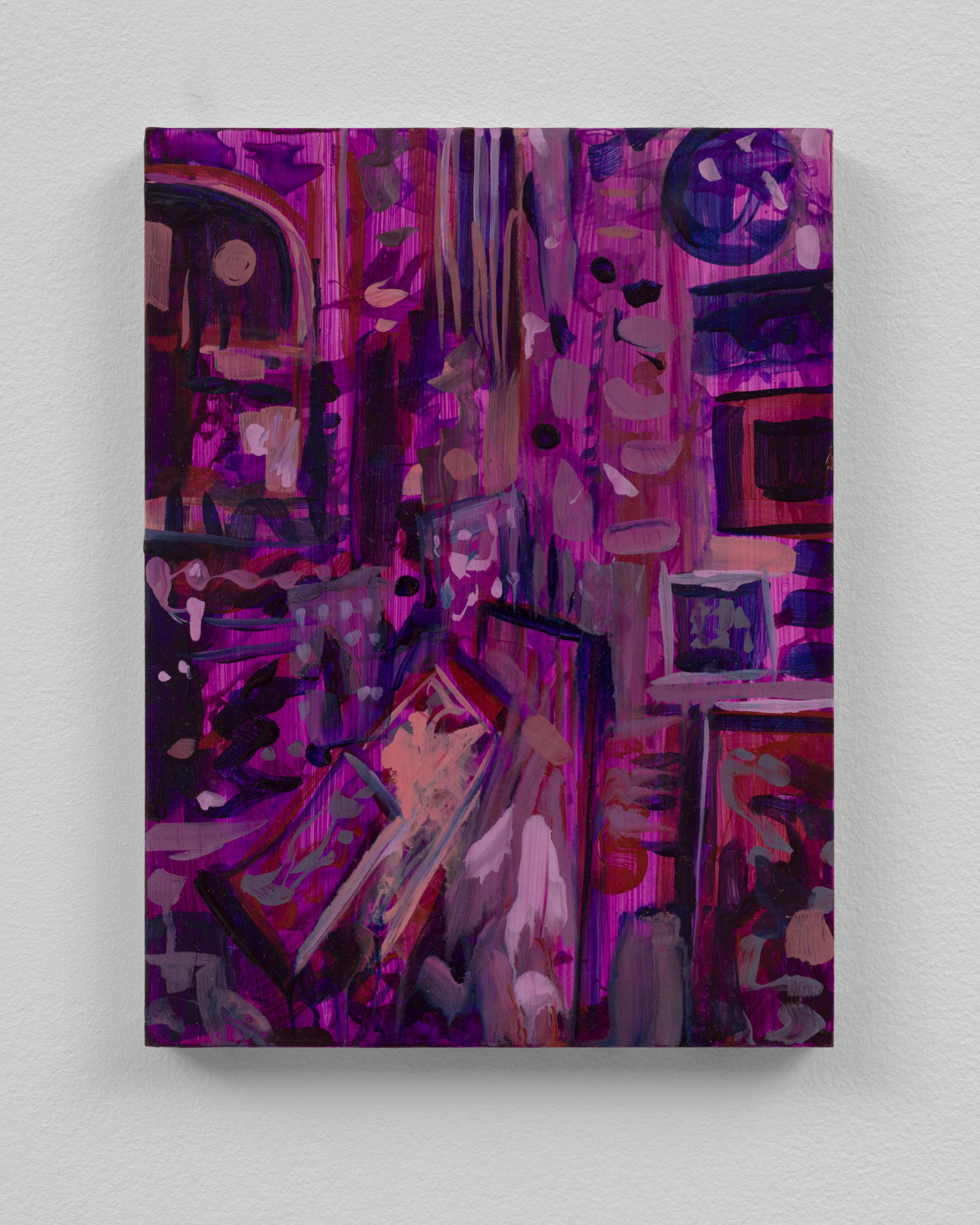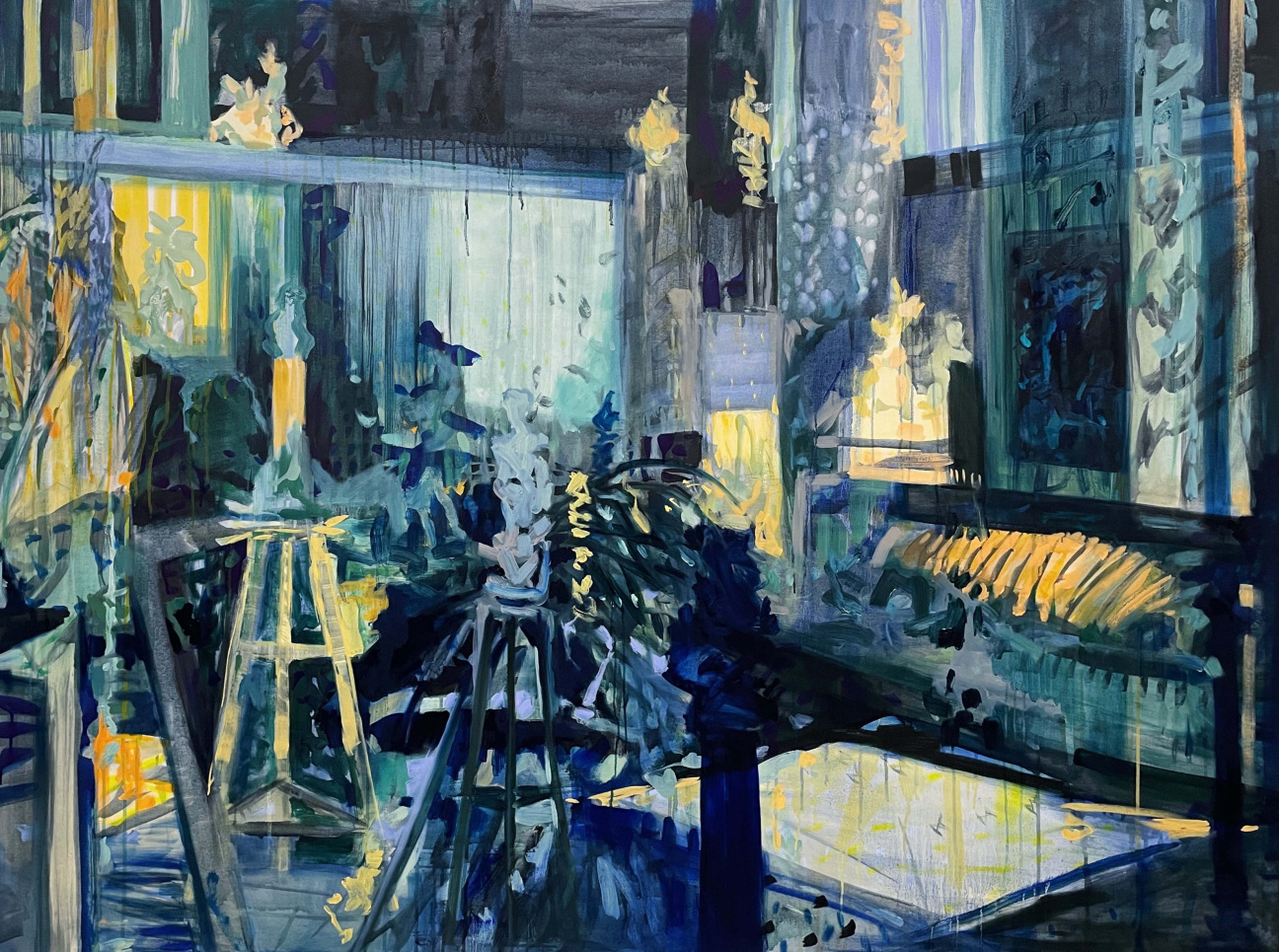
It’s no secret that an artist’s studio is more than just a place. They’re more akin to another limb, or a physical extension of one’s brain. Brooklyn-based artist Elizabeth Schwaiger, whose painted interiors have often dissected what our spaces say about ourselves, has cultivated an intimate relationship with her studio for decades—she even admits to feeling more at home in it than her own body. The key to their affinity? “Time, untethered passion, hard work, focused attention, responsiveness, openness, letting the boundaries of oneself extend past the skin until your mind occupies a greater space and ‘outside’ connections become as natural and active as a synapse,” she tells CULTURED.
"Now & Now & Now," her first exhibition with Nicola Vassell Gallery in New York since the announcement of her representation in December, navigates the boundaries between internal and external realities, shaped by the lens of pregnancy and postpartum. Fresh off of the show’s opening, Schwaiger shares her insights into the profound impact of research on her creative process; slipping between metaphor and literalism; and what stepping into the cataclysm looks like.

CULTURED: How does it feel to be presenting your first solo exhibition with Nicola Vassell Gallery?
Elizabeth Schwaiger: Thrilling. I’ve loved working with Nicola and her team and couldn’t be more pleased with the way our relationship is developing, in no small part because of their unequivocal support through pregnancy and matrescence, which aligned with, and was catalyst for, the creation of this body of work.
CULTURED: How does your foundation in research inform your artistic practice?
Schwaiger: If I had no creative outlet I would still spend much of my time, maybe even more of my time, digging into the peculiarities of reality, which is, in a word, research. One of the dynamics of the work in “Now & Now & Now” is the knowledge that reality is not solely the domain of the external but that the internal is equally real, that consciousness itself might actually have more space for reality than the outside universe, and more importantly, that the boundaries between the two are as porous as a sieve, if they even exist at all.

CULTURED: What kind of research went into "Now & Now & Now"?
Schwaiger: The exhibition at Nicola Vassell is my most introspective to date, but is still very much informed by a breadth of research which includes (in mostly this order): comparative pregnancy and childbirth and control of women’s bodies through time and across culture; creative/destructive feminine archetypes and the link between magic, divinity, and the feminine; celebrity and mythification in art history; eschatology, apotropaics, and the warding off of the apocalypse or the role of ritual in the face of inevitability; natural and man-made disaster; the nature of time and space; the nature of color perception (always this!); the nature of the self. It’s endless. How could it not be?
CULTURED: You’ve explored themes of power dynamics and climate crises in the last 10 years. Are there any allusions to these topics in this particular collection of works?
Schwaiger: When this first entered into my work it seemed so much more hypothetical than it does now. It was almost like I was using flooding and climate crises as symbols for a broader idea of humanity’s hubris in all areas, not just ecological ones. Now it’s so immediate, so specific, that the meaning has become more acute. I think it will always be a part of my work, even if somehow we find our way out of our self-inflicted environmental tragedy.
The new thing about the work in this exhibition is the idea that we are nature. It’s that again this inside/outside stuff is an illusion or paradox at best, and that our damage to our world is self-harm writ large, and like all self-harm, it is rooted in trauma.
The terrifying power of nature is within us while remaining just as uncontrollable. Anyone who has been pregnant knows this viscerally. Through this valence, the art historical idea of the sublime (the trembling awe induced by comparative scale with nature) can be discovered not on the cliff’s edge, but instead with an inward gaze. That is what is at the heart of these paintings. A recognition of untamed nature bursting through despite any attempt to draw a square boundary to contain it or contain ourselves from it.

CULTURED: What are some examples of visual symbolism viewers will get to experience in "Now & Now & Now," and what is the story behind them?
Schwaiger: In my work there is a great deal of intended slippage between metaphor and literalism. The painting is a painting of a studio, and that studio is just a studio. But it’s also a symbol for many other things—the self, creativity, art historical baggage, letting go, the tension between chaos and control—and then again, it's just an interior space. And so everything in the show is visual symbolism and it is not. It’s both. Always. Simultaneously.
But to get back to your point, motifs that a viewer might spot in the work include: frames, pedestals, sculpting stands, and rigid architecture that can represent a human tendency to sort, understand, compartmentalize, hem in, or shield; lighting reminiscent of the unnatural upward cast of streetlamps through apartment windows that can invoke the uncanny and the psychology of the sleepless; and of course plants, which bring in powers of growth, entropy, nature, chaos, the uncontrollable, and the feral feminine.

CULTURED: You’ve mentioned the experience of surrendering and letting go to forces greater than yourself, such as childbirth and scuba diving, as influences for your artistic practice. How did you surrender to the process of creating the works in this exhibition?
Schwaiger: When anything extraordinarily powerful is working well, and I have any part in it, there is this peculiar combined sense of, one, being in a space above my interior monologue and two, letting go of preconceived plans, of what I first thought was needed, and instead responding to or riding the moment. It feels like more of an immediate embodied way of existing than what I tend to experience day to day. It’s not something that I can step into on command.
Mihaly Csikszentmihalyi calls it "flow" and in many ways, that state is what “Now & Now & Now” is all about—realizing you are in the ocean and you are the ocean, realizing, in childbirth, that you are consciousness and a portal for new consciousness, that your body knows what it is doing even if other parts of you do not, embracing the whirlwind of creation and destruction that can overtake you in the studio or in any other facet of life, stepping to cataclysm, to the void, and letting go.
CULTURED: What do you hope viewers take away from "Now & Now & Now"?
Schwaiger: In the moment they leave I want them to feel full, satiated, with the lingering deliciousness still in their eyes, but with the distinct sense that there was more to their visual feast than just color and composition. In the walk home or on the subway or years later, I want them to find the dimensional overlay and conflict in a reflection in the windows, or atop their phone screen as they scroll, or in the play of light through steam. I want them to feel they are moving through a less stable external reality and maybe a more stable internal one, to find parity between the two, to hold fear and awe and recognition of the sumptuousness of existence in the same breath, the same thought, the same image.
"Now & Now & Now" is on view through February 24, 2024 at Nicola Vassel Gallery in New York.










 in your life?
in your life?

